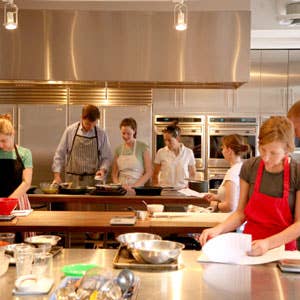
Creativity by Design
The writers and photographers of this magazine travel to every part of the world to trace the origins of regional foods and culinary traditions, but at its heart, SAVEUR is a publication about what happens at home, in the kitchen—about the deeply gratifying, universal act of cooking. That's why one of our principal missions has always been to develop and test (and retest, and retest) our recipes with the home cook in mind. So, when our editorial staff recently moved its offices to a space on New York City's East 32nd Street, the opportunity to create a new test kitchen from the ground up was tantalizing. The facility, a 926-square-foot work area and dining room that shares an open-plan floor with the editors' offices and workstations, has become the physical and creative hub of the magazine. Just like a home kitchen, ours is a busy, welcoming place where the staff tastes various dishes, compares cooking techniques, and exchanges ideas. "The kitchen is the engine of what we do at the magazine," says SAVEUR's test kitchen director, Hunter Lewis.
That said, we place demands on our space and on our equipment that exceed those of even the busiest home kitchen. For any given issue, Hunter and his staff must test as many as 40 recipes to make sure that the instructions are foolproof and that the dishes come out just right. On a recent workday during the making of the present issue, Hunter shuttled between the kitchen's central cooktop island, where he was monitoring a double boiler full of chocolate and butter destined for a batch of brownies, and his desk, situated in an alcove within the main kitchen area, where he was researching sources for the rennet needed for making ricotta. Nearby, assistant kitchen director Ben Mims was toiling over several simmering pots, trying to determine what kind of beer worked the best for cooking bratwurst, while, a few feet away, kitchen assistant Krystal Stone was whisking sake with white miso to make a miso sauce.
During our first magazine close—that hectic period when we're preparing to ship the issue to the printer—we discovered that our new kitchen could also feel like home. Editors would wander over to the fridge, page proofs in hand, looking for a snack. Late at night, the work islands would become conversation hubs, with some folks hopping up to sit on the counter while they talked and ate. While this dynamic arrangement feels completely organic, it hardly happened by accident. Clodagh, the New York-based designer who created our kitchen and dining room, is famous for integrating open kitchens into larger living spaces and for her affinity for natural materials and serene, low-maintenance environments. "I love kitchens and the overlay of art and function," she says. "I wanted it to feel comfortable, a place where you can cook efficiently but still be creative." Clodagh's design is the product of an intensive process in which she and her team helped SAVEUR's staff to articulate its wants and needs.
What strikes many first-time visitors to the kitchen that Clodagh came up with is the look and feel of the sensuous, textured surfaces. "We chose stainless steel for durability and ease of maintenance," the designer explains, "and walnut doors to keep things from coming off as too cold." She called on artisans with whom she's worked for years to create the space's built-in features. In the dining area, Rick Cuneo installed deep cabinets made of honey-colored maple, and Gregory de Laura and Tracey Stakelin of Delform Partners turned out a recessed sideboard and a long, low window bench in polished concrete. It was fascinating to watch them pour ordinary concrete and then, over the course of several days, sculpt and buff it until it had a veneer as smooth to the touch and as richly patterned as marble.
A cardinal rule in the SAVEUR test kitchen has always been that we use only those kinds of utensils and equipment one would find in a typical home kitchen. Because of the volume of food we have to prepare and cook, we opted for the highest-quality, most durable home kitchen appliances to be had. Two large side-by-side refrigerator-freezers and two refrigerator drawers, both by Sub-Zero, along with a Thermador column freezer, offer ample space for the ingredients we use in our dishes, as well as for the items that cooks, farmers, and purveyors from around the world send us for sampling. And, much to the satisfaction of Ben, who handles a lot of the baking, our three Wolf ovens display the exact temperature at all times and maintain extraordinarily even heat distribution. A microwave and a warming drawer, also from Wolf, help us to keep all the elements of a menu at the proper temperature until everything is ready to serve.
My favorite part of the kitchen, hands down, is the pair of eight-foot-eight-inch- by three-foot islands that command the center of the room. One, topped with deeply grained, cocoa brown walnut, is our main prep table and chopping block. The other comprises two five-burner Wolf electric cooktops and a sturdy cast-iron grill. Each of the units' bases consists of a grid of cubbyholes where we keep our most frequently used pots and pans. These islands were originally conceived as conjoined units, but in the sort of happy evolution that a genuinely accommodating design makes possible, they may be kept separate so that traffic flows more freely around and between them. In addition to the islands, we have a movable cart, made by Thermador, that holds an electric cooktop and oven; it's essential for in-house photo shoots, which often require moving the food we're cooking to wherever the quality of light in the office happens to be the best. Last but not least, two Kohler sinks and two Thermador dishwashers, in operation almost ceaselessly, help us keep the kitchen tidy—a crucial requirement in such a busy place.
Keep Reading
Continue to Next Story










